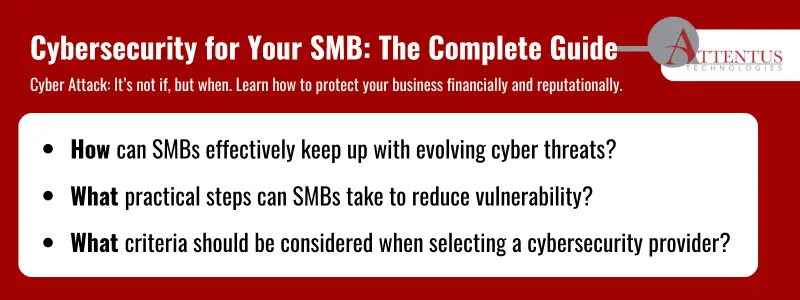Cyber Attack: It’s not if, but when. Learn how to protect your business financially and reputationally.

The statistics are dire: 48% of small and medium-sized businesses (SMBs) worldwide fell victim to a cyber attack in 2023. And 25% of them experienced multiple incidents. Between 2020 and 2022, attack volume increased 150%, equating to 31,000 daily attacks. In the United States, 73% of small business owners said they were targeted.
Of course, the first question is, “Why are SMBs a favorite of cybercriminals?” The rationale stems from the common hurdles small enterprises encounter, notably a scarcity of internal resources, outdated tools and technology, and limited budgets, all of which are easily exploited by cyber adversaries keenly aware of these vulnerabilities.
New threats emerge every second, and to avoid the dire consequences of a data breach, SMBs must be aware of these, know how to protect themselves, and know who to turn to for help. In this guide, we’ll highlight the importance of cybersecurity and what you need to know to ensure your business’s protection.
Why cybersecurity is important
The average cost of a data breach is more than $4 million. For SMBs, that figure is much lower, but the total impact, both financially and operationally, is much more devastating. Of SMBs who have suffered an attack:
- 42% report financial losses
- 32% said they lost customer trust
- Faced an average recovery time of 279 days.
- 60% closed within six months of the hack
When you take into consideration all of these factors plus system downtime and reduced productivity, you can easily see how the costs—both financially and reputationally—can add up.
SMB Cybersecurity Essentials
The first step in any cybersecurity strategy is risk assessment. This involves analyzing your business information systems – from hardware to software to mobile devices – to identify current and potential vulnerabilities.
This can be challenging for a non-expert. However, an I.T. managed services provider (MSP) can quickly and effectively perform a vulnerability assessment and identify threats.
Next, develop a strategy
After completing the assessment, the MSP can work with you to develop strategies to prevent and mitigate them. This can include firewall implementation, anti-virus software, other tools, and, importantly, creating employee cybersecurity policies.
Secure Wi-Fi networks
Make sure your Wi-Fi network is secure, encrypted, and hidden. Your MSP can set up your access point or router so the network name is not broadcast and protect access to these devices.
Train employees
The methods hackers use to infiltrate your systems vary, but one thing they can always count on is human error. A study by IBM found that human error was the cause of 95% of cybersecurity breaches. Mistakes are made by those who know better but are tired or distracted, and poor decisions are made by those who are not properly trained. Regular cyber-security training is vital to avoiding a data breach.
Create a strong password policy
Simple passwords are gifts to hackers. You might be surprised that the most commonly used passwords are a string of sequential numbers – 123456 – and the word “password.”
Set a policy that requires employees to create strong passwords and change them regularly. Strong passwords include:
- More than 12 characters
- A mix of uppercase and lowercase letters, plus numbers and symbols
- Uniqueness. Passwords should be unique to each account, so if a single password is compromised, it can’t be used to access multiple systems.
Implement multi-factor authentication
While a strong password is a good start, phishing, keylogging, and social engineering can undermine even complex ones. This makes multi-factor authentication an essential part of cybersecurity for SMBs. Multi-factor authentication (MFA) requires users to provide multiple forms of identification to access your network.
In addition to a password, users are asked to enter a code sent to their email, answer a secret question, and, in some cases, verify their identity via a fingerprint scan. With multi-factor authentication, passwords are protected, and cybercriminals have difficulty gaining access.
Limit access
Everyone in your company doesn’t need access to every piece of information. Never provide one employee with access to all data. Grant employees access only to the specific systems and apps they need to do their jobs. Also, installing any software without specific permission should be prohibited.
Access to business computers should also be limited. Laptops are easy targets for thieves, so make sure they are locked when unattended.
Keep software updated
Exploiting software vulnerabilities is a common way for hackers to infiltrate. Prevent this by keeping all software current, including operating systems, anti-virus software, and applications. Since updates often include patches for known and newly discovered vulnerabilities, failure to implement them can make your business ripe for an attack.
Don’t forget mobile devices
If your employees use their phone or tablet for work, setting cybersecurity policies for these devices is essential. Require:
- Password protection that follows company cybersecurity policy
- Data encryption
- Security app installation
Also, advise employees to avoid public networks such as those in coffee shops and airports.
Backup your data for easy recovery
Cybersecurity isn’t just about preventing attacks. It also includes implementing a recovery plan. Make sure you backup data regularly, including documents, spreadsheets, databases, financial and human resources files, and files for accounts receivable and payable. All of this information is valuable to hackers. Your MSP can set up automatic backups to the cloud to make this seamless.
Monitor, monitor, monitor
Hackers never rest. While you’re sleeping, a bad actor with a laptop across the world can have their greasy fingers in your network and devices. Your MSP can deploy state-of-the-art monitoring tools to identify threats in real time, no matter when they happen, and swiftly respond.
Regularly update your cybersecurity strategy
Evolving threats are increasingly sophisticated as cybercriminals look for new vulnerabilities to exploit. At the same time, technology is evolving, and new hardware and software can impact your cybersecurity strategy. An updated approach may be needed to address new vulnerabilities or to take advantage of a new security feature.
Protect the cybersecurity of your SMB with Attentus
For more than 20 years, Attentus has been improving cybersecurity for SMBs to protect their digital assets, reputation, financial solvency, and peace of mind.
Attentus can help you with everything from:
- Risk assessment
- Employee security awareness training
- Incident response
- Software updates and patches
- Installing VPNs on Wi-Fi networks to secure internet connectivity
- Threat monitoring
- Recovery planning
- And more
Book a free consultation to learn more about how we can help you fend off cybersecurity threats and preserve operational integrity.
